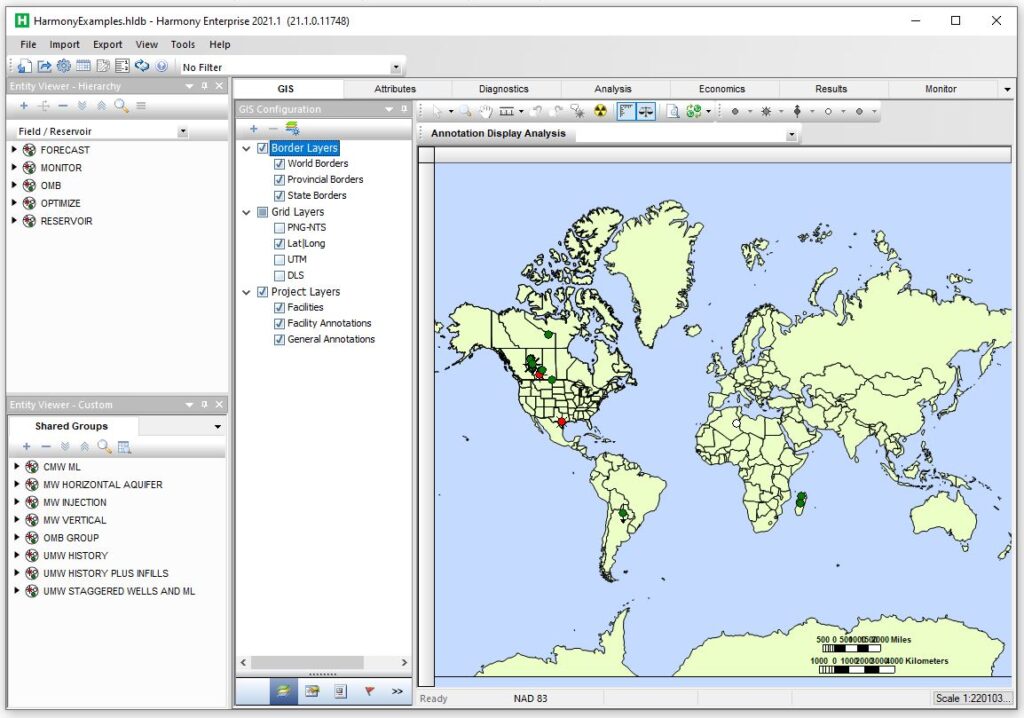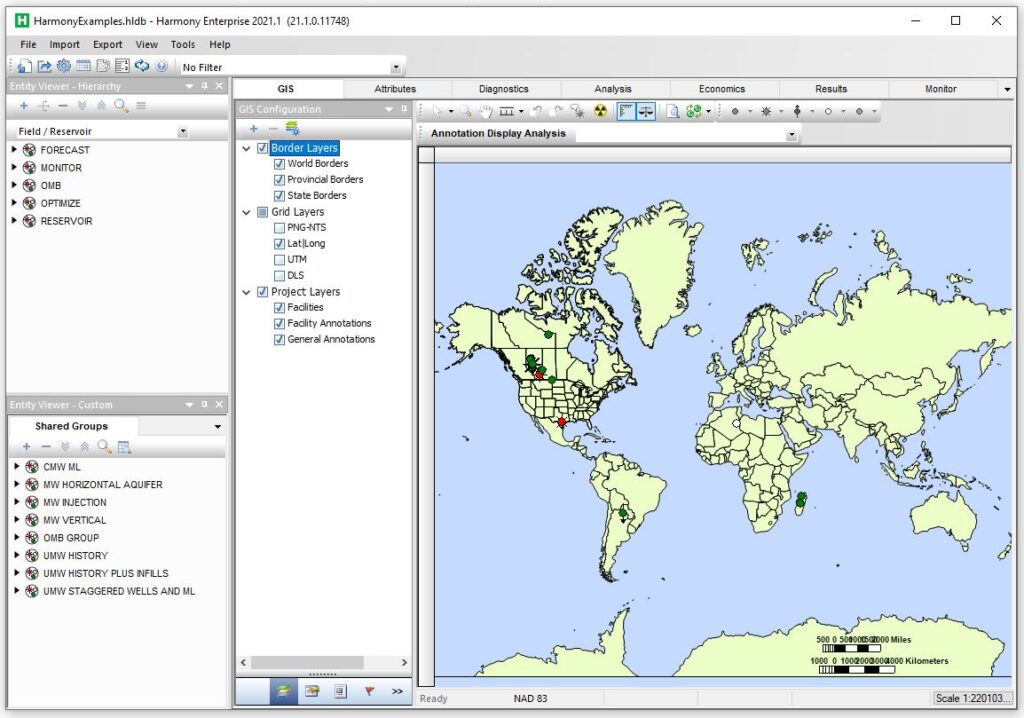
Harmony Enterprise 2021.1 Release Notes
Probabilistic Decline (beta)
Account for production uncertainty by creating decline forecasts for user-specified percentiles (for example, P90 / P50 / P10). You can specify the range of b values sampled. After creating your percentiles, Probabilistic Declines can be modified, exported, and used throughout Harmony Enterprise in the same way as traditional declines.
Quickly produce sensitivities on numerical model forecasts
Previously, numerical model calculations always ran from the beginning of production. Now, when only the forecast parameters have changed since the model was last run, only the forecast period is being recalculated, making the forecast optimization workflow faster. This enhancement applies to all single-well numerical models.
Import of VirtuWell analyses
We now support importing VirtuWell analyses from .harmony files. Existing VirtuWell analyses are imported as the corresponding Optimize analyses. This includes Gas AOF / TPC, Oil IPR / TPC, Pressure Gradient, and Advanced Forecast analyses.
Note: Scenario wellbores in the Wellbore editor are imported as additional wellbore configurations of the Physical wellbore, with a date of 2095 (which can be customized).
Linear Fit Custom Gas IPR
Enhanced line fit for custom table IPR curves. You now have the option to use a linear interpolation in addition to the Forchheimer pseudo-pressure curve fit.
Push IPR from Advanced Forecast to Nodal worksheets
Send up to 10 IPR curves at a time from an Advanced Forecast worksheet to an IPR / TPC worksheet using the new Send To functionality.
Minor improvements and resolved issues from Harmony Enterprise 2020.3
General
Decline forecasts pulled to Analytics Explorer can use a combination of early time daily resolution followed by monthly resolution. A tool can be accessed from the Entity Viewer to easily update existing declines in bulk.
An Expand All icon has been added to the Entity Viewer toolbars.
The Entity Viewer – Hierarchy now includes a count of the selected wells and scenarios.
To save time, the Production vs. Forecast Monitor date defaults to the last day of production.
The Analysis Type column has been added to the Results Viewer - Grid View.
Analyses in the Analysis Manager are now sorted alphanumerically.
Templates and workflows are now sorted alphanumerically.
The formula for a diagnostic line can now be displayed as an annotation.
The Results Viewer – Grid view has a new icon to export the grid to a .csv file.
.hldb files have a size limit of 10 GB. A warning is now displayed when opening projects larger than 8 GB.
An option has been added to the Help menu to restore the docking panes and toolbars to their default locations.
As Propnum is now a built-in attribute, if a custom attribute exists with this name, it is renamed, which no longer prevents your Harmony Enterprise database from upgrading.
Default workflows are now provided if no previous workflows have been created.
Fixed the Time axis issue that could occur when Time was on the x-axis, and all axes were changed to Coordinate or Log using the plot’s drop-down list.
LocalDB 2019 is now used for *.hldb files (we previously used LocalDB 2014).
Gauge depth is now included when copying a Wellbore configuration.
The option to “Do not show again” has been added for warnings that are displayed when deleting a worksheet or analysis.
To determine how long a license has been in use, the Start Date column in the Current Users dialog box now includes the date and time to differentiate between users who obtained a license on the same day, but at different times (for example, 1 hour vs. 7 hours of use).
Fixed a crash that occurred when displaying the Wellbore Configuration column in the Production editor for a group.
Drop-down lists in the Options dialog box now display correctly for higher-resolution monitors.
CoalAPI and ODBC trace logging can be enabled from the Options dialog box.
The build number is now included in the Harmony Enterprise title bar.
Imports + Exports
Well Scenarios can now be included when calculating sandface pressures following an import.
When importing through the Enerdeq Direct Connection or from .98c files, you can now elect to import oil and condensate data as reported (default setting), or import to a single column (as oil or condensate).
Simplified importing from FieldDIRECT, so you can simply browse to your FieldDIRECT database.
TLS 1.2 is now the preferred security protocol, which is used when importing from Enerdeq.
Added the “New” import option for wellbore data updates. If the “New” option is selected, a wellbore configuration for a given well is imported only if there is no existing wellbore configuration on the same date.
When importing analyses from ARIES, a worksheet is only created if one does not already exist, which prevents accumulating duplicate worksheets.
You can now specify whether declines imported from ARIES were completed on calendar or operated rate.
When configuring a new database import connection, the source database units default to the Harmony global display unit system (that is, field / imperial or metric).
The production preview in the Database Import Wizard displays data in the same units mapped for the source database.
The option to import new custom attributes and datasets has been changed to deselected by default (applies when importing .harmony and .hldb files).
The field “Area Name” has been renamed to “Property” in the Database Import wizard to match the Attributes tab’s field that it is mapped to. Note that existing connections are unaffected.
Fixed an issue that caused a custom group to not import, if a member well already existed but with a different internal ID.
The fields “Primary Fluid” and “Reservoir” are now included when importing wells from IHDC.
Imports from IHDC now support company names that include an ampersand (&).
Fixed a crash that could occur when calculating sandface pressures following an import, if multiple wells failed to update due to required inputs being incomplete.
The bulk forecast export now includes an option to export with daily resolution when available.
When opening the Export wizard or Filters dialog box, selections are only initialized from the Entity Viewer if fewer than 200 wells are selected (otherwise, these dialog boxes take too long to open).
Forecast
Added the option to specify a minimum b value for the initial best fit on a traditional decline.
Deleting a reference date now also deletes any classified analyses associated with that date.
Added a new parameter “dlimDate”’ for declines with dlim This parameter indicates when the analysis transitions from hyperbolic to exponential.
The decline best fit has been modified to allow the dlimDate to occur prior to the forecast start date.
The b value of a decline segment with dlimspecified can now be finely adjusted through line manipulation.
The default setting for several Arps decline analysis fields can now be set in the Options dialog box:
Calc Method.
Decline rate (dsec dtanvs. a).
Limiting decline rate method (dlimexp vs. dlimhyp).
Well offsets in Typewell can now be positive or negative, which allows the dataset to be shifted forward or backward.
Corrected the plotting on cumulative vs. time worksheets to the end of the period (previously mid-period was used).
The default maximum value for b for an initial best fit on a traditional decline analysis is now set to 2 (the previous default setting was 5).
Reservoir
You can now set the gridding to be used by default for single and multi-well numerical models in the Options dialog box.
For analytical and numerical models that include nf, this parameter now defaults to the Attributes tab value. This parameter is not populated by default for URM analyses, but the Attributes tab value is available in the Defaults and Limits dialog box.
The conventional multi-well model has been fixed to immediately update after changes are made to group properties.
Fixed the calculation of absolute permeability in URM for gas-water systems.
Fixed the calculation of fluid produced for group Typecurves if production includes empty values.
FMB correctly uses dry vs. recombined gas for liquid-rich gas wells depending on whether multiphase is enabled.
Filtering has been fixed in FMB, so that it is synchronized between all datasets.
APE is now disabled for analytical and numerical models until at least one parameter is selected.
Fixed the plot headers for Typecurves, so that the current well name is displayed when worksheets are added via a workflow.
Corrected the material balance for certain multi-layer numerical models for flow into 0% saturation cells.
Parameters in the conventional multi-well model can now be edited in bulk if any of the well names include a “/”.
Fixed the broken link to online help from the conventional multi-well model’s gridding parameters.
Fixed a crash in the conventional multi-well model that occurred if the reservoir boundary included a cut out.
Fixed the crash that occurred when the path to the installation directory included Unicode characters, and a Typecurve was opened. Note that the Typecurve stems are not displayed if this occurs.
CBM numerical models are now ignored when importing *.harmony files.
Optimize
Advanced Forecast now defaults to the wellbore configuration active at the forecast start date for wellhead forecasts.
Fixed the liquid-loading step calculation, so that it is consistent between the Liquid Loading Monitor and Advanced Forecast.
Fixed a crash that could occur when pasting improperly formatted data into the custom IPR table.
Forchheimer Gas Inflow now populates with reservoir properties specified in the Properties tab.
Flowing Gradient now properly handles simultaneous injection of oil and gas.

您暂时无权访问此隐藏内容!
密码文件(S):密码:www.gopaysoft.com




